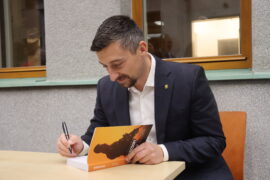
02 French Flintlock Rifle, Ch. Koerber, Ingelfingen, c. 1810. Hunting rifle of Frederick I (1754−1816), the first King of Württemberg (1806−1816).
Fotogalerie
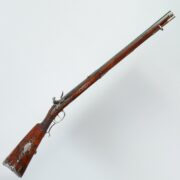




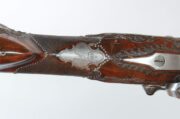
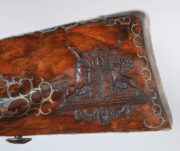
The rifle comes from a pair of identical weapons made around 1810 in his workshop in Ingelfingen by the gunsmith Christian Koerber for King Frederick I of Württemberg (1754–1816).
We have no information on how passionate a hunter the King of Württemberg was, but he certainly participated regularly in hunts and hunting parties. After all, hunting had been the favourite and often only sport of the nobility since the Middle Ages. It was at the hunts that important marriages, alliances and war plans were arranged.
Both hunting rifles with a French flintlock have practically identical dimensions; their lengths differ by only a centimetre (1,079 mm and 1,091 mm), and their weight by only a few grams (3,172 g and 3,020 g). The 13.7mm iron octagonal barrels are fitted with seven grooves. The surface of the barrel is blued and decorated with silver damascening vine tendrils and leaves. On the deadbolt of the bottom bolt, the number 1 is engraved in the first case, and the number 3 in the second. This means that the rifles were not made in pairs, but as a set of at least three.
Rich noblemen, hunters were often not satisfied with the rate of fire of their rifles and therefore ordered whole sets of rifles from their gunsmiths, most often twelve identical rifles. This allowed them to shoot much faster than with any contemporary rifle or repeating rifle. During the hunt, the serving personnel would then constantly reload and retrieve the fired rifles, so that the shooter had another loaded weapon immediately available. Another advantage of such set of weapons was the equal length and weight, and above all the identical ballistic properties of all rifles.
In addition to the beautiful ornamental decoration and the numerical markings on the bottom screw, the barrels also bear the signature “CHRETIEN KOERBER A INGELFINGEN” on the top, which is again made using the silver damascening technique in a rather complicated script. The name Chretien is the French equivalent of Christian. The history of European gunsmithing mentions two masters with the name Christian Koerber, both of whom worked in Ingelfingen in Württemberg. The older of the two is estimated to have been active from 1750 to 1785. He was court gunsmith to the Duke of Hohenlohe and especially to the Duke of Württemberg. The second Christian Koerber is mentioned only in 1828, but as the displayed arms prove, he was obviously active in the branch earlier. The number of surviving products of both gunsmiths in collections around the world is small; however, as a rule they are high-end examples that were produced in small numbers for the wealthiest clientele.
The lock plates of both rifles have a rounded shape and their surface is finished in high gloss. In one case, the surface of the plate is completely smooth, in the other gun the signature “C. Koerber” is engraved. The rifles are full-stock, with a glossy polish on the surface. The stocks are made of high quality walnut rootwood. Due to the differences in hardness and twisted structure, it had to be fixed by gluing from the beginning of the stock maker’s work. The was due to various cracks and a lack of cohesion of the material. Therefore, stocks made of this material often show spots that have been repaired by the manufacturer himself. The result of his work was always an original stock resembling a richly textured marble. It was enough to finish the surface with a high gloss, and the result was a perfect work of art coming out of the gunsmith’s hands.
The surface of both rifles’ stocks is richly decorated with recessed, ornamentally carved silver plate, silver beads and especially very high quality carvings. This is dominated by the beautiful Württemberg royal arms, including the shield-bearer, jewel and banners, placed on the left side of the buttplate behind the cheekpiece. The fittings of the stock are silver and consist of ten parts in total. Grips of both stocks bear a thumb plate with the monogram “FR” (Fredericus Rex) below the royal crown, confirming that these are indeed the hunting handguns of King Frederick I of Württemberg.
Length 1091 mm, barrel length 704 mm, calibre 13.7 mm, weight 3,172 g.
Aktuálně

Výzkum u českých krajanů v Chorvatsku

Československý deník sehrál v životě legionářů v Rusku velmi důležitou roli. Poprvé vyšel v prosinci 1917

Děkujeme za podporu pro válečné veterány. Sbírka DiGiMÁK vynesla 450 tisíc korun
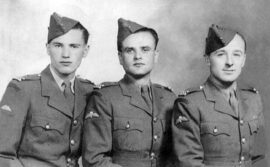
Tak trochu zamrzlé spojení
